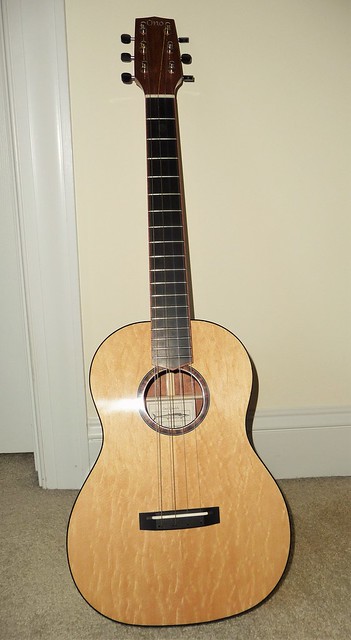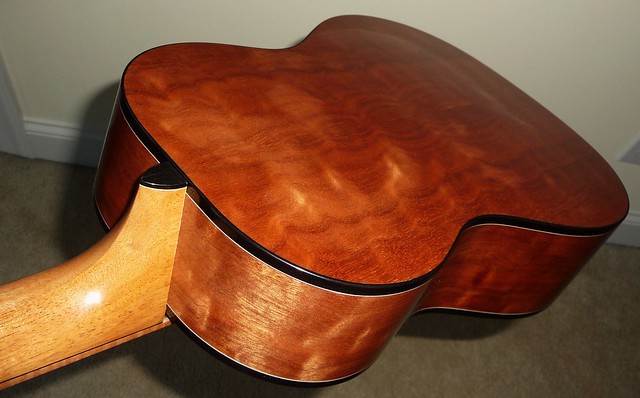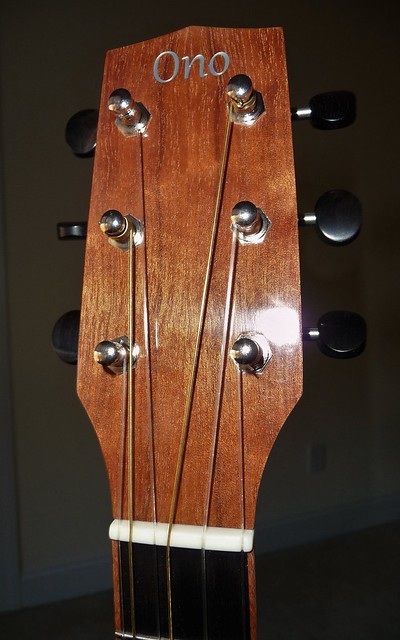Doc_J
Well-known member
I’ve been wanting to write a review of this amazing 6-string baritone for a while. But, holiday travels and a post-holiday flu, and the start of new semester have delayed me.
I’m the lucky person who got the Ono 6-string bear claw spruce/ Makore baritone with octaves on strings 3 and 4. Couldn’t resist its beautiful sound.
The octaves on strings 3 & 4 are more versatile to me than the Lili’u tuning 6-strings, with octaves on strings 1 & 3. It sounds great strummed or played finger style on any song I have played. The Lili’u tuning seems more of strummer. The SouthCoast strings with octaves on strings 3 & 4 really sound outstanding, and make this baritone so rich, clear, resonant, and with great harmonics.
Of course, the build of this Ono is flawless and gorgeous. It’s a real easy player, too. Hands down, it's the best baritone I have played. Actually, this 6-string baritone is in a class by itself, with its haunting, clear, rich, full tone. This is the 3rd instrument I have that was made by David Ingalls/Ono Ukuleles. Each was built to perfection. But this is the first Ono with a glossy lacquer finish that I have had. The finish is SUPERB !
It’s really well balanced and a different animal from a regular 6-string or 4-string baritone, in a very good way.
Here’s the specs:
Here’s a brief sound sample from me and a couple pictures below.
https://app.box.com/s/deybha1g1xxdqr10aa1h2hlkiz43rzpi
Corey did an amazing demo of it.
https://vimeo.com/244502116
pictures:
https://flic.kr/s/aHsmb7ETqz
 P1080709 , on Flickr
P1080709 , on Flickr
 P1080710 , on Flickr
P1080710 , on Flickr
 P1080711 , on Flickr
P1080711 , on Flickr
 P1080720 , on Flickr
P1080720 , on Flickr
I’m the lucky person who got the Ono 6-string bear claw spruce/ Makore baritone with octaves on strings 3 and 4. Couldn’t resist its beautiful sound.
The octaves on strings 3 & 4 are more versatile to me than the Lili’u tuning 6-strings, with octaves on strings 1 & 3. It sounds great strummed or played finger style on any song I have played. The Lili’u tuning seems more of strummer. The SouthCoast strings with octaves on strings 3 & 4 really sound outstanding, and make this baritone so rich, clear, resonant, and with great harmonics.
Of course, the build of this Ono is flawless and gorgeous. It’s a real easy player, too. Hands down, it's the best baritone I have played. Actually, this 6-string baritone is in a class by itself, with its haunting, clear, rich, full tone. This is the 3rd instrument I have that was made by David Ingalls/Ono Ukuleles. Each was built to perfection. But this is the first Ono with a glossy lacquer finish that I have had. The finish is SUPERB !
It’s really well balanced and a different animal from a regular 6-string or 4-string baritone, in a very good way.
Here’s the specs:
- 20" scale
- Makore back and sides
- Master grade Sitka bearclaw spruce top
- Honduras mahogany neck with carbon fiber reinforcement
- Nitrocellulose gloss finish
- Cantilevered 16" Radius ebony fretboard with curly Makore binding
- Ebony bridge
- Ebony bindings
- Monterillo rosette
- Carbon fiber bridge plate
- Unbleached bone nut and saddle
- Waverly Tuners
- Strung with South Coast LHL-WB
Here’s a brief sound sample from me and a couple pictures below.
https://app.box.com/s/deybha1g1xxdqr10aa1h2hlkiz43rzpi
Corey did an amazing demo of it.
https://vimeo.com/244502116
pictures:
https://flic.kr/s/aHsmb7ETqz
 P1080709 , on Flickr
P1080709 , on Flickr P1080710 , on Flickr
P1080710 , on Flickr P1080711 , on Flickr
P1080711 , on Flickr P1080720 , on Flickr
P1080720 , on Flickr
Last edited:
